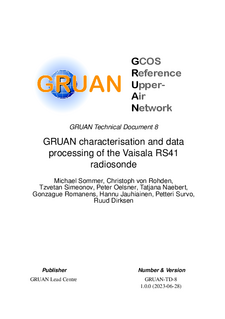GRUAN characterisation and data processing of the Vaisala RS41 radiosonde
GRUAN-TD-8
Details
- ID
GRUAN-TD-8
- Title
GRUAN characterisation and data processing of the Vaisala RS41 radiosonde
- Authors
Michael Sommer, Christoph von Rohden, Tzvetan Simeonov, Peter Oelsner, Tatjana Naebert, Gonzague Romanens, Hannu Jauhiainen, Petteri Survo, Ruud Dirksen
- Last version
v1.0.0 (2023-06-28)
- Status
Published
- Download
Abstract
The Vaisala RS41 radiosonde is used for operational atmospheric observations within the Global Climate Observing System (GCOS) Reference Upper-Air Network (GRUAN). It is in use since 2014 and currently in operation at more than 15 GRUAN sites with approximately 800 soundings per month, and thus contributes significantly to the volume of GRUAN observational data. The network was established with the ambition to provide atmospheric measurements of Essential Climate Variables (ECVs) and other variables with reference quality. Beside the use of appropriate instruments that are capable of meeting the reference criteria, data products are developed in GRUAN (GRUAN Data Products, GDPs) which are based on raw data and include high quality, reference-level product data of the variables measured by the instrument together with uncertainty estimates.
This document collects technical information on the construction and working principles of the RS41 radiosonde and its sensors, provides information on the software and hardware equipment, and provides guidance on the practice for the routine preparation and conduction of soundings with attention to the requirements in GRUAN. The pre-launch procedures at the ground include the full implementation of manufacturer-prescribed ground checks before performing independent checks of humidity, temperature and pressure in stabilised environments (Standard Humidity Chamber, SHC) as part of a GRUAN sounding preparation to verify the manufacturer calibration. No corrections are applied based on these GRUAN ground checks. However, the results may contribute to the uncertainty budget.
Furthermore, comprehensive information is presented on the GRUAN-developed processing of the raw data coming from the sensors for temperature, water vapour, pressure, and GPS, and leading to the final product variables (air temperature, relative humidity, pressure, altitude, wind speed and wind direction, and further derived variables) in its first version (RS41-GDP.1). The information applies to all sub-variants of the RS41 radiosonde, as the types of installed sensors are the same. The processing includes algorithms based on results from extensive laboratory experiments that have been performed to characterise the physical sensors with respect to the quantification of systematic biases. The most important of these biases are the solar radiative warming of the temperature sensor and the strong increase of relative humidity sensor response time at low temperature. The current data product version (RS41-GDP.1) focuses on the ascent part of radiosoundings until the balloon bursts, i.e. descent data are not included in the GRUAN Data Product (GDP).
An important component of the processing and therefore of the RS41-GDP.1 is the estimation of uncertainties which is done for each measured variable, vertically resolved, and combining them in a consistent way following the guidelines in the Guide to the Expression of Uncertainty in Measurement (GUM) when deriving final magnitudes (JCGM, 2008).
Each uncertainty component contributing to the combined final uncertainty of the actual variable is assigned a correlation property. Three correlation types are used, namely ‘uncorrelated’, ‘spatially correlated’, and ‘temporally correlated’. Although the strength of correlations is generally variable, a simplistic approach assigns a complete degree of correlation for the two correlated types, i.e. corresponding to a correlation coefficient of r = 1, and no correlation (r = 0) for the uncorrelated. This assignment is based on assumptions rather than on substantial covariance analyses. The correlated and uncorrelated uncertainties are, together with the product variables and their combined estimated uncertainties, stored in the provided GDP files. With this concept, the user is offered the way to include the effect of correlations of uncertainties on a rough level according to specific needs of an analysis or study using the RS41 data.
The GRUAN data processing system (GDPS) for radiosondes ingests calibrated raw data together with a set of metadata. It is clearly structured, easily configurable and modular, and as such also designed to be adaptable to other radiosonde models. This document summarises information on the format and extent of the input data, the processing steps, and some basic information on the composition of the RS41-GDP.1 output files in NetCDF format (see also GRUAN-TN-13).
History
- v1.0.0 (2023-06-28)
Sommer et al., GRUAN characterisation and data processing of the Vaisala RS41 radiosonde. GRUAN Technical Document 8 (GRUAN-TD-8), v1.0.0 (2023-06-28).
